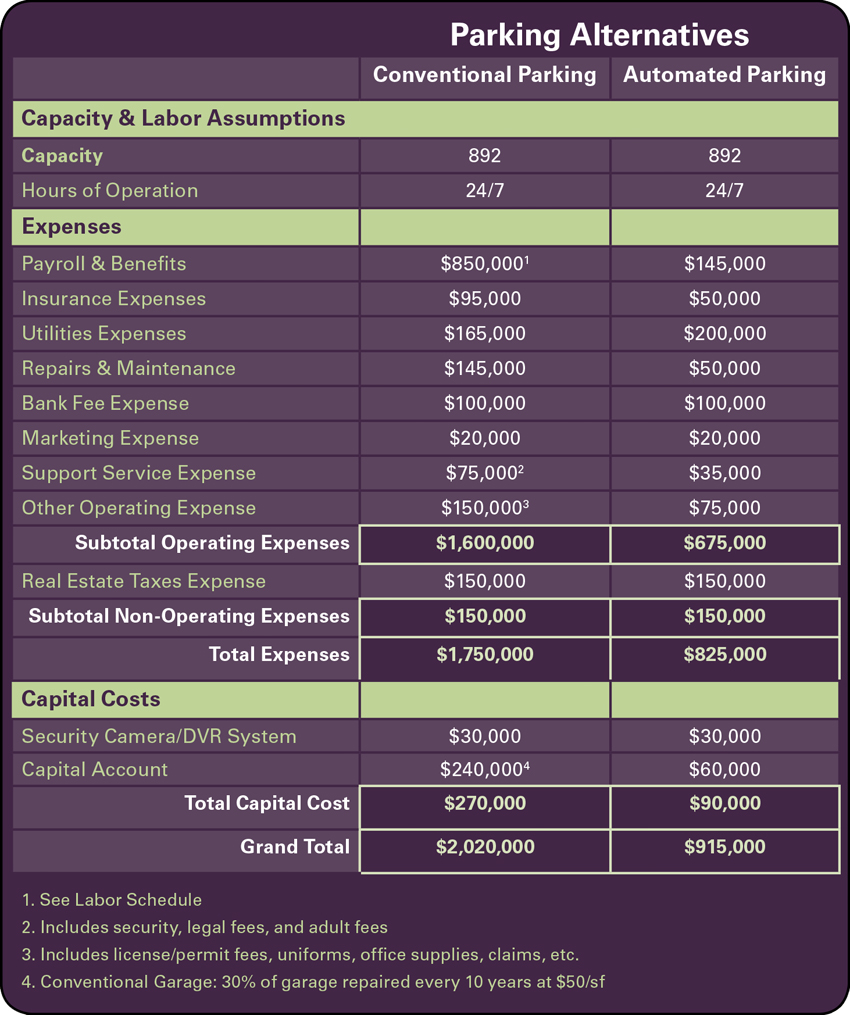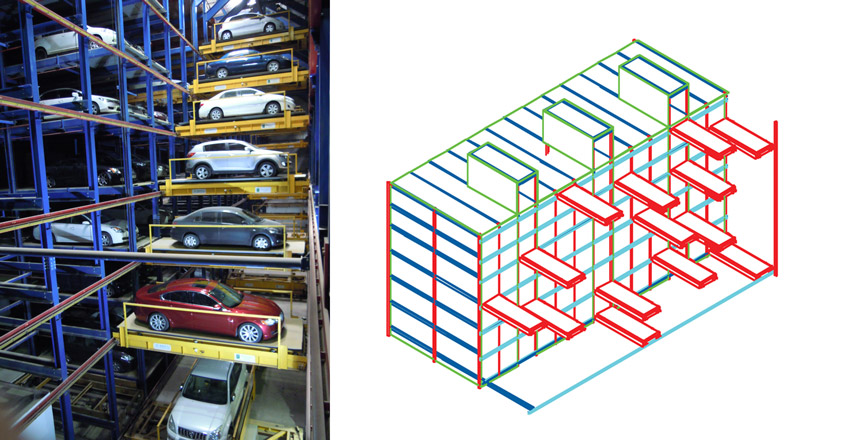The Largest Robotic Parking Systems in the World: Is the United States Ready for This?
Significant Land-Use Benefits and Positive ROI of Automated Parking
While parking may seem like an afterthought to some, providing an automated parking system could be the centerpiece of a project and if done well may provide the ROI that allows a project to go forward, or not. To assess the real cost of parking options, Samuel I. Schwartz, PE, a former transportation commissioner of New York City, compared the operating and capital costs of an 892-space conventional garage versus those of an automated parking facility. Schwartz concluded that, when all factors are considered, the cost of operating an automated garage is less than half (a 55 percent savings) than that of a conventional garage.
In his paper titled “The Garage of the Future Must Be Green,” Schwartz states, “An owner can save over $1.1 million per year with automated parking. In the current real estate climate, this is equivalent to capital cost savings of over $15 million.”5 Schwartz also stated that the useful life of a conventional concrete parking garage is about 20 years. The earliest European mechanical/automated systems show little to no wear after more than 50 years of usage. An example is the parking system of Deutsche Bank in Musnich, Germany, which was installed in 1956 by the Krupp Corporation.

Shown are comparisons of expenses and capital costs for a case study in Upper Manhattan, New York City.
All Spaces ADA Compliant
Depending on the robotic parking manufacturer, all entry/exit terminals should not only be compliant with the American With Disabilities Act (ADA), but they also tend to be extra large and comfortable.
For a quality installation, the minimum width of each standard terminal will be larger than 15 feet, which means each walkway has 4 feet of equal clearance on the left and right of the parked car. The minimum width of the ADA entry/exit terminals is 12 feet of car slot and 5 feet minimum on one side for the walkway for wheelchair access. This is 17 feet width in total.
Considering the Number of Stories
Besides attention to the local zoning code requirements, there are other limitations for conventional parking garages. For example, users generally avoid driving more than 6 levels of ramps. Automated parking can reach higher than 15 levels.
There may also be local zoning benefits derived from automated parking because an automated parking system can be considered a 1-story building. This is because systems can be designed using a rack system with concrete only on the floor and ceiling of the entire space. In a rack system, the levels are constructed from removable steel structure and inserted machinery.
Capacity and Scalability
In 2001, a leading automated parking manufacturer made a major development in the automated parking industry with the development of “lift-and-run” technology. To understand why this technology is revolutionary, it is necessary to understand how it was done previously (and is still being done by many).
Above are images that demonstrate an older and widely used technology. This type of system relies on one machine to transport each vehicle from the entry terminal up to its final parking space. This means that the machine goes up to the final parking destination with a car and returns to the entry terminal empty to pick up another car in morning rush hour (for example). This is inefficient.

Shown is an example of older technology that relies on one machine.
The new patented lift-and-run technology, shown below, uses the principle of “passing” the load from one machine to another: It lifts the vehicle, runs with it for a certain distance on one of the X, Y, or Z coordinates (directions), and then passes it to another machine that is operating on another coordinate. This is much more efficient than having one machine do the entire transportation cycle along all three axis and increases the overall speed of the system.

Advanced technology, known as “lift and run,” passes the load from one machine to another.
A major benefit of lift-and-run technology is its scalability. These systems are built like a layered cake. A layered cake alternates between cake and frosting. In order to have a bigger cake, one only needs to add another lay of cake and frosting to the top.
Lift-and-run parking is constructed in the same way, except its layers go from side to side. Each layer consists of machines that “lift” vehicles vertically (the cake) and machines that “run” cars horizontally (the frosting). To increase the size of the parking structure, one needs only to add a “layer” of lift-and-run machinery to one side.
Repeating instances of lift-and-run machinery create a system that is scalable in a way that a system that depends on “bookend lifts” cannot be.
Adaptive Reuse for Floor Space
In some automated parking systems, space can be reconfigured for future uses, including storage use by introducing containers (also for cold-storage use or nitrogen use). Much depends on the structure of the facility. Is it comprised of steel racks or concrete decks? Facilities with steel racks can be more easily adapted than traditional concrete parking garages and automated parking garages that rely on concrete for each level.

This illustration shows how an automated parking structure could be retrofitted for future needs.
As the illustration above shows, the system can be taken out and the space reallocated for other uses by providing ample heights. The system, partially or entirely, can be relocated to another location, allowing developers to convert the parking slot into other usable space. All or a portion of the parking spaces can be reused as storage spaces by providing container-like covering on top of the pallet.










